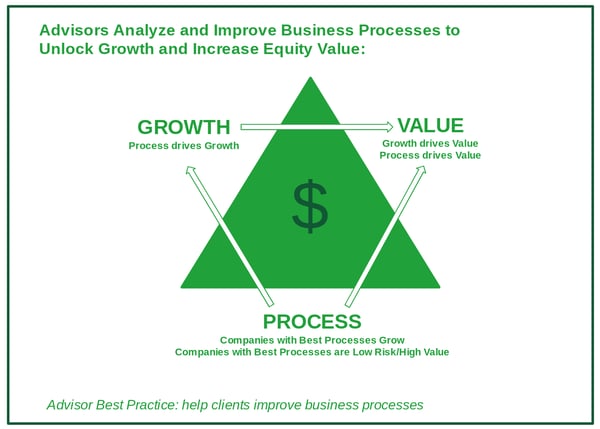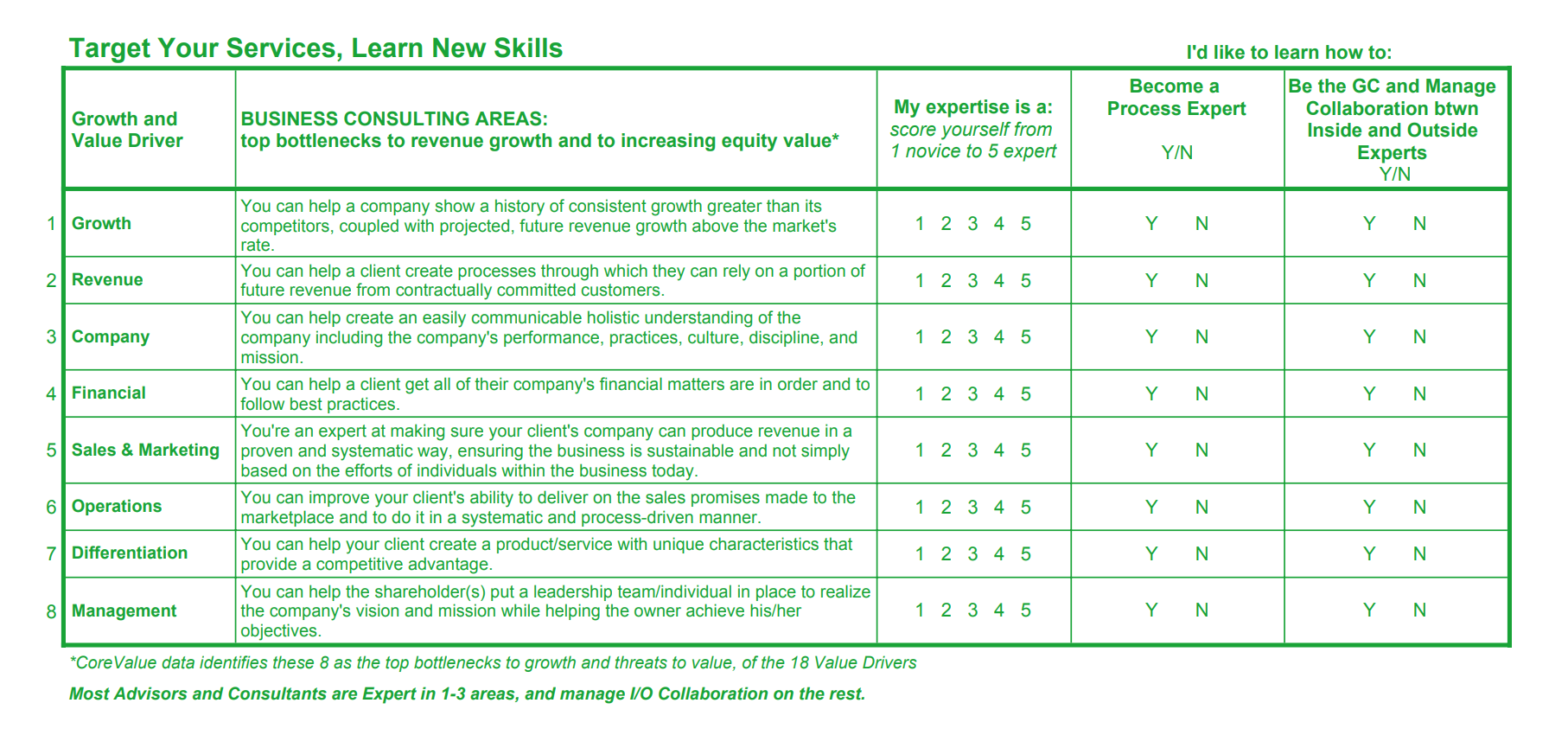Business Advisory Roles: Architect (create a strategic plan), General Contractor (manage plan execution), and Trades (consult on specific projects within the plan).
Business Advisor Series Article 3
The first article in this series described the difference between a Business Advisor and a Business Consultant. The Business Advisor works as a peer to the CEO supporting their essential function: maximizing shareholder value. To increase shareholder value, the Advisor and CEO work on strategy, and on converting strategy into growth-driving tactics. Inside the company, tactical execution is the President's responsibility; externally this is a Consulting function. Great examples of ‘tactical consulting’ include the Accountant who helps implement Operating Reports, or the Management Consultant who converts sales momentum into a replicable process.
|
In delivering services to Middle Market companies1 there is an intersection between the Business Advisor and the Personal Advisor. In this intersection both are more effective when they collaborate to the client’s benefit. Senior Executives of Middle Market Companies are often the largest shareholder. The company must one day deliver both the operational strength needed to successfully cash out the value and the net cash must be sufficient to fund the owner’s wealth goals. This collaboration is the subject of the Growth and Exit Planning Conference this February. |
Companies (and consulting practices) do not grow and thrive by accident, they grow and thrive by having (1) a plan, and (2) a process for converting the plan into reality. In creating the plan the Business Advisor serves as Architect. In managing execution of the plan the Business Advisor serves as General Contractor. Outside professionals delivering driver-specific tactical expertise serve as Consultants, analogous to a Tradesperson.
Architect ⇒ General Contractor ⇒ Trades
ARCHITECT
The 'Business Advisor as Architect' analyzes the client company, and delivers a blueprint for growth. The blueprint should focus on improving operational strength. As discussed in Business Advisor Article 1, strategic focus is triangulated on Business Process, Growth, and Value.2 One cannot maximize enterprise value nor generate predictable growth without having strong operational processes. Put another way, and CoreValue's data bears this out, strong companies grow and are valuable.3

By analyzing the strength of business processes, the Business Advisor can generate an operational strength and value report which becomes the blueprint for an executable growth plan. When implemented, this transforms the client company from today’s status quo into a company that meets the CEO’s goals. The Business Advisor as Architect sets the stage for Growth.
|
Business Advisors report service fees for providing the ‘Architect’ Operational Strength and Value Report between $4,500 and $10,000 depending on company size, project goals and complexity. These three variables drive fee structure for both planning and execution services. One top pro put it this way: “The CEO should have no problem investing 1% of gross [revenues] into services that will unlock growth or make [the company] easier to run.” |
Architect ⇒ General Contractor ⇒ Trades
With an Operational Strength and Value Report in hand, the Business Advisor is in a logical position to act as the General Contractor who manages the project to improve business process, drive growth, and maximize value. In the General Contractor role the Advisor is responsible for working with the CEO to:
- Craft driver-specific projects and assign them to the internal team
- Where outside expertise is needed, help the CEO identify and hire Consultants
- I/O Collaboration: facilitate collaboration between the internal management team, existing outside experts, and project-specific consultants
- Manage accountability for project completion
- Deliver progress reports to the CEO based on improved driver scores, increased value, and/or revenue growth
Architect ⇒ General Contractor ⇒ Trades
TRADES
As General Contractor you will need to assign driver-specific projects to the 'Tradespeople' i.e. the internal team and/or outside experts. This is Inside/Outside or ‘I/O’ Collaboration, through which you as the Business Advisor help focus all activity on improving business processes, unlocking growth and increasing value.
No single advisor has specific subject matter expertise across all 18 of the client company’s operational drivers. While you may have “5 of 5” competence in 1, 2 or even 3 drivers that allows you to provide those tactical consulting services, these go beyond the role of Architect and General Contractor. Do you have driver-specific expertise allowing you to also propose and deliver consulting projects?
Most experienced professionals do. To decide what services you can personally provide in your 'Business Advisor as Consultant' role, and which you should deliver through collaboration, analyze your expertise. Start with the top 5 areas (there are 18 value drivers total) for which middle market companies consistently report weakness, plus the top 2 Red Flag threats to growth and value.4 Rate yourself from 1-5 for each category.
|
Business Advisors who provide 'Trades' consulting services typically propose well-defined projects. The fees for these projects vary widely. In a tactical consulting role, you are responsible for a specific deliverable, for example creating operating reports. The fee bell curve for ‘Trades’ consulting services to Middle Market Companies range between $6,000 and $50,000 depending on company size, project goals and complexity. Remember, these services deliver a quantified 10X to 20X ROI to the client in increased enterprise value, plus revenue growth. |
You can learn collaboration best practices at the Growth and Exit Planning Conference this February.
Recap:
- The 'Business Advisor as Architect' analyzes the company's operational performance and delivers a valuable report, which is the executable blueprint for growth
- The 'Business Advisor as General Contractor' implements the executable growth plan, holding the inside team and outside experts accountable for improving business processes. Improving processes unlocks growth and value.
- The 'Business Advisor as Tradesperson' can also deliver project-specific consulting services in those areas where they are a subject matter expert.
- Work as Peer to the CEO: training is available to learn how to be the Business Advisory Architect, General Contractor, and I/O Collaboration expert.
[1] Middle Market Companies, as that term is used here, are those with Gross Annual Revenues between $2.5MM and $70MM.
[2] See the “Growth Matters” section in Chapter 2 of Breakthrough Companies. McFarland, K. (2008). Breakthrough Companies, New York City NY: Crown Publishing Group.
[3] CoreValue data © 2018.
[4] Red Flags are threats to some the company’s ability to grow and/or deliver value to the shareholders. Example: the CEO micromanages day-to-day operations. The company’s numbers may look great, but without the CEO the company cannot function.

 Download this form
Download this form